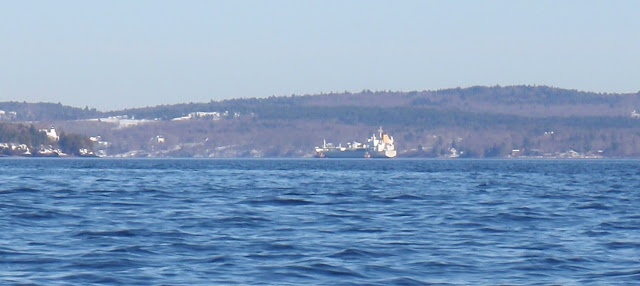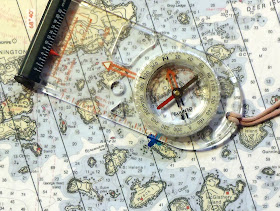We have been inundated with trap tree news this fall. A trap tree is a Christmas tree made by piling up lobster traps (some places call them lobsterpots.) Rockland, which has built a trap tree
since 2003, held two lighting ceremonies this year. One in Mid November, filmed for a
2011 Discovery special on interesting Christmas trees, the second a week later. Meanwhile, on Beals Island, the community was working to build the
world’s largest trap tree.
Being easily swayed by media, I began to feel I should actually see a trap tree live and in person. But which one: the Beals Island one, which was the biggest; or the Rockport tree, which was the original? I’ve never been to Beals Island, located Downeast of here. I’ve been to Rockland, which is just over an hour southwest on the midcoast. Rockland has a downtown filled with bakeries, restaurants, galleries and gift stores. Beals Island, as I read in Guide to Sea Kayaking in Maine by Shelley Johnson and Vaughan Smith, has Island Variety, a convenience store.
But Beals Island has another feature which is far more appealing to a kayaker: the Great Wass Archipelago, a series of more than 50 islands. It looked like there was an easy loop out through the inside of the islands, around Eastern Bay, stopping at an island with a lighthouse on it. I read Mark some of the descriptions of the islands, many of which are sea bird sanctuaries, thus off limits for much of the spring and summer. When I got home from work the next night there was a chart on the table. “That chart’s a little small” Mark explained, “I’ll redo it in two sections.” Then he added temptingly, “You know ocean water is warmer than the Penobscot now.”

Boy, that chart looked inviting. I could see the route, either from the Jonesport ramp, or from Beals Island. The ledges run all through Eastern Bay, lots of short jumps of less than a half mile. Absolutely perfect for a September jaunt. Tempting even for a late paddle, though without knowing anything about the currents, and with a destination called Mistake Island, it seemed like maybe it was best to wait.
So with reasons to see both, we decided to visit both trap trees, and scout the two locations for launch sites.
Since our first available day coincided with rain, we planned a trip to Rockland. The tree is located by the Fisherman’s Memorial and the Rockland Public Launch, 152 traps make up this tree.
The public launch is just down the hill, and the Rockland breakwater is just visible as a gray line to the left.
It is topped with a lobster holding a star, and decorated with dozens of lobster buoys.
The public launch has a small gravel beach from which kayaks can be launched. There is also a public beach nearby. My favorite feature is this nearby park filled with marine relicts.
 |
| See how the bell has been worn away by the striker |
Another launch site is available further from the center of town on Snow Street, beside the
Coastal Children's Museum and the
Snow Marine Museum . It looked pretty empty, but the state of Maine resources guide describes it as the busiest
ramp in the area.
But the real joy of this trip was visiting the downtown.
We had a nice lunch, which gave Mark a chance to make sure no work crisis had erupted. Then we went window shopping
 |
| Decorations at Seagull Cottage |
 |
| I'm not sure how many bakeries exist in Rockland, 4, 5 more? |
Our next trip was up to Beals Island. The storm system had stalled overhead, so this day was also gray with a steady mist. It was a long drive there through very rural Washington County, an area where you need to be self sufficient to survive. The tree came into sight as we went over the bridge.
 |
| Not only is an island in view, but someone is working on the boat. |
This is a much bigger tree, made with 769 traps, and topped with a fisherman in yellow oilcloth.
 |
| Either I've shrunken to half size, or this tree is twice as big |
And it was plainly made with recently used traps: bricks and barnacles decorated the interiors.
But what was even more evident was how busy the working waterfront is in the area.
There were plenty more traps in case a larger tree was desired.
The water was filled with boats, with more on shore waiting to join in. Traps stored on shore indicated that in the summer access to launch points would be very limited, and the need to be on guard for working boats paramount.
 |
| Jonesport Launch |
The
Jonesport launch was described as having adequate parking, but was nearly full already. The shrimp season had just opened. The
Beals launch was fairly empty, but hardly spacious and looked like it was a critical area allowing commercial fisherman access to the water.
Beals Island has a seasonal take out stand but Island Variety has been closed for years. Hikers would be interested in the trails on Great Wass Island, on land managed by the Nature Conservancy. Nearby Jonesport has some scattered stores, and is also the launch point for Norton Puffin tours. I’d hoped to eat at
Tall Barney’s in Jonesport, named for a
local giant. But though there were cars in the lot, it was closed, as was the nearby diner.
So we began our trip home. As we passed along route 1 in Addison a hand painted sign noted that the Bohemian Mama’s Bakery was open, and had a tiny “WIFI” lettering added. Since Mark needed to check in, we decided to stop. About a mile off route 1 at 251 Ridge Rd we came to the bakery.
No web page, but a
facebook site Inside was a case full of scones, puff pastry, bars and other treats, as well as a rack of loaves and rolls. And on the counter were samples of their wood fired brick oven pizza. Delicious! We settled in at a table, and soon were splitting a pepperoni pizza. Their menu lists several amazing deserts, and has been stored away for future use. Sadly, in the winter they are open only two days a week.
So, though the Beals tree was bigger, I have to rate Rockland as the better winter experience. However, hikers looking for wild coast line would probably prefer Beals Island. And, I feel our trip to Beals Island was not wasted, the sheer number of boats there makes that a much different paddling area than I’d expected. I hope to get back there again when the weather is better, maybe after bird nesting season ends and probably on a Sunday, when traditionally lobster boats stay home. I did find that Ray Wirth had done a
winter trip to Beal, which you might enjoy reading.
And I also think this proves that if you build something wicked big, people will come and spend money in your area.























































